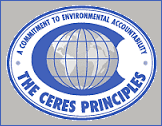The Valdez Principles, subsequently called the Ceres Principles, are a set of ten guidelines designed to regulate and monitor the conduct of corporations in matters relating to the environment. The guidelines seek to better inform the public and establish audits and reports on their environmental impact. They were drawn up in 1989 after the Exxon Valdez oil tanker disaster which ran aground and spilled more than 10 million gallons of crude off the Alaskan coast.
The sustainable investment movement was inspired by the Valdez Principles which were instituted by sustainable business nonprofit Ceres (Coalition for Environmentally Responsible Economics). The ten rules guiding the investment practices came to be known as the Ceres Principles. They require that investment decisions minimize risk to the environment and promote sustainable use of natural resources.
The CERES Principles is a ten-point code of corporate environmental conduct to be publicly endorsed by companies as an environmental mission statement or ethic. Companies that endorse these Principles promise to go voluntarily beyond the requirements of the law, and publicly assert their belief that corporations have a responsibility for the environment.
The CERES pledge
The pledge that CERES signatories make is as follows:
'By adopting these principles, we publicly affirm our belief that corporations and their shareholders have a direct responsibility for the environment. We believe that corporations must conduct their business as responsible stewards of the environment and seek profits only in a manner that leaves the Earth healthy and safe. We believe that corporations must not compromise the ability of future generations to sustain their needs.
'We recognize this to be a long-term commitment to update our practices continually in light of advances in technology and new understandings in health and environmental science. We intend to make consistent, measurable progress in implementing these Principles and to apply them wherever we operate throughout the world.
1. Protection of the biosphere
'We will minimize and strive to eliminate the release of any pollutant that may cause environmental damage to air, water, or earth or its inhabitants. We will safeguard habitats in rivers, lakes, wetlands, coastal zones and oceans and will minimize contributing to the greenhouse effect, depletion of the ozone layer, acid rain or smog.
2. Sustainable use of natural resources
'We will make sustainable use of renewable natural resources, such as water, soils and forest. We will conserve non-renewable natural resources through efficient use and careful planning. We will protect wildlife habitats, open spaces and wilderness, while preserving biodiversity.
3. Reduction and disposal of waste
'We will minimize the creation of waste, especially hazardous waste, and wherever possible recycle materials. We will dispose of all wastes through safe and responsible methods.
4. Wise use of energy
'We will make every effort to use environmentally safe and sustainable energy sources to meet our needs. We will invest in improved energy efficiency and conservation in our operations. We will maximize the energy efficiency of products we produce and sell.
5. Risk reduction
'We will minimize the environmental health and safety risks to our employees and the communities in which we operate by employing safe technologies and operating procedures and by being constantly prepared for emergencies.
6. Marketing safe products and services
'We will sell products or services that minimize adverse environmental impacts and that are safe as consumers commonly use them. We will inform consumers of the environmental impacts of our products or services.
7. Damage compensation
'We will take responsibility for any harm we cause to the environment by making every effort to fully restore the environment and to compensate those persons who are adversely affected.
8. Disclosure
'We will disclose to our employees and to the public incidents relating to our operations that cause environmental harm or pose health or safety hazards. We will disclose potential environmental, health or safety hazards posed by our operations, and we will not take any action against employees who report any conditions that create a danger to the environment or pose health or safety hazards.
9. Environmental directors and managers
'We will continue to improve management resources to implement the CERES principles. This includes monitoring and reporting our implementation efforts, and sustaining a process to ensure that the board of directors and chief executive officer are kept informed of and are fully responsible for all environmental matters. We will establish a committee of the board of directors with responsibility for environmental affairs. At least one member of the board of directors will be a person qualified to represent environmental interests to come before the company.
10. Assessment and audit
'We will conduct and make public an annual self-evaluation of our progress in implementing these principles and in complying with applicable laws and regulations throughout our worldwide operations. We will work towards the timely creation of independent environmental audit procedures which we will complete annually and make available to the public.'
In 1996 Aveda become the first beauty company to adopt the CERES principles. Some of the other early CERES signatories include Amercan Airlines, Bank of America, Baxter International, Ben & Jerry's, Best Buy, The Body Shop, Coca-Cola, Conslidated Edison, Dell, Dunkin Brands, eBay, Exelon, Ford The Gap, General Mills, GM, ITT, Levi Strauss, Louisville Sewer District, McDonald's, Nike, PepsiCo, PG&E, Sun Microsystems, Sunoco, Timberland Company, and Time Warner.
See also the Ceres Climate Declaration
- Blogger Comment
- Facebook Comment
Subscribe to:
Post Comments
(
Atom
)

0 comments:
Post a Comment